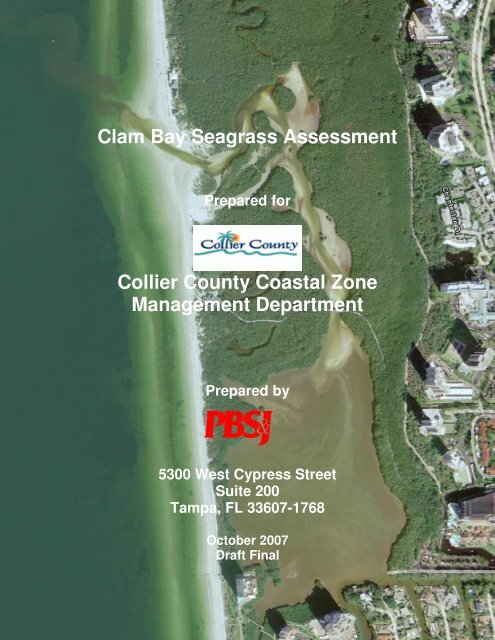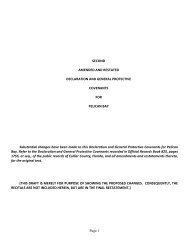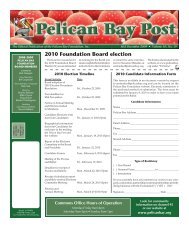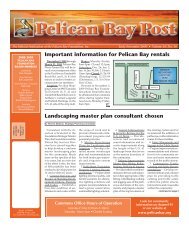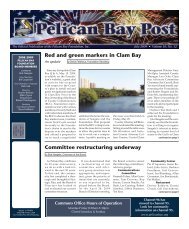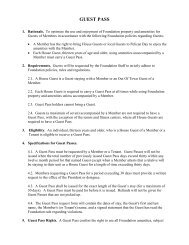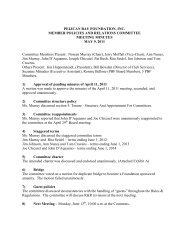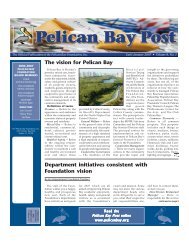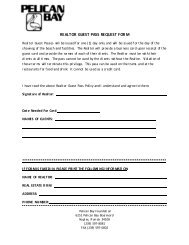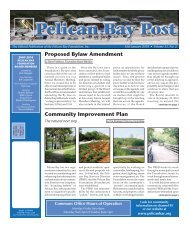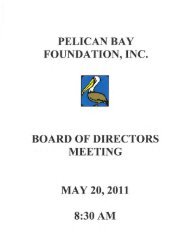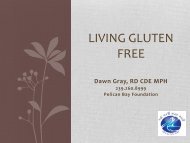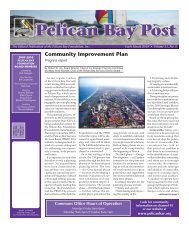Clam Bay Seagrass Assessment Collier County Coastal Zone ...
Clam Bay Seagrass Assessment Collier County Coastal Zone ...
Clam Bay Seagrass Assessment Collier County Coastal Zone ...
You also want an ePaper? Increase the reach of your titles
YUMPU automatically turns print PDFs into web optimized ePapers that Google loves.
<strong>Clam</strong> <strong>Bay</strong> <strong>Seagrass</strong> <strong>Assessment</strong><br />
Prepared for<br />
<strong>Collier</strong> <strong>County</strong> <strong>Coastal</strong> <strong>Zone</strong><br />
Management Department<br />
Prepared by<br />
5300 West Cypress Street<br />
Suite 200<br />
Tampa, FL 33607-1768<br />
October 2007<br />
Draft Final
Table of Contents<br />
Table of Contents.......................................................................................................................................... i<br />
1.0 Introduction .....................................................................................................................................1<br />
1.1 Development of <strong>Clam</strong> <strong>Bay</strong> .................................................................................................1<br />
1.2 <strong>Seagrass</strong> Mapping .............................................................................................................3<br />
2.0 Methods ..........................................................................................................................................7<br />
2.1 Task 1 – Kickoff Meeting and Stakeholder Interviews .......................................................7<br />
2.2 Task 2 – Data Collection on Depth Distribution of <strong>Seagrass</strong>es and Potential<br />
Water Clarity Goals for <strong>Clam</strong> <strong>Bay</strong>......................................................................................7<br />
2.2.1 <strong>Seagrass</strong> Sampling...............................................................................................7<br />
2.2.2 Water Quality Sampling ........................................................................................8<br />
2.3 Task 3 – Development of Estimated Freshwater and Pollutant Loading Estimates<br />
for the <strong>Clam</strong> <strong>Bay</strong> Watershed..............................................................................................9<br />
2.3.1 Model Development ..............................................................................................9<br />
2.3.2 Major Watersheds...............................................................................................11<br />
3.0 Results ..........................................................................................................................................16<br />
3.1 <strong>Seagrass</strong> distribution........................................................................................................16<br />
3.2 Water Quality ...................................................................................................................23<br />
3.2.1 Based on the data collected, what were the general water quality<br />
conditions in <strong>Clam</strong> <strong>Bay</strong> during our study? ..........................................................25<br />
3.2.2 What water quality parameters (i.e., turbidity, phytoplankton, and “color”)<br />
best explain differences in water clarity? ............................................................25<br />
3.2.3 Which nutrient, nitrogen or phosphorus, best explains differences in<br />
phytoplankton abundance?.................................................................................26<br />
3.2.4 Are our conclusions in-line with prior assessments of water quality in<br />
<strong>Clam</strong> <strong>Bay</strong>?...........................................................................................................28<br />
3.3 Pollutant Loading Model ..................................................................................................31<br />
3.3.1 Net Pollutant Loads.............................................................................................33<br />
4.0 Conclusions and Action Plan ........................................................................................................36<br />
5.0 References....................................................................................................................................40<br />
i <strong>Clam</strong> <strong>Bay</strong> <strong>Seagrass</strong> <strong>Assessment</strong><br />
DRAFT October 2007
Contents<br />
List of Figures<br />
Figure 1.1 Aerial Photo (circa 1940s) of <strong>Clam</strong> <strong>Bay</strong> and immediate watershed .................... 1<br />
Figure 1.2 Aerial photograph (2006) of <strong>Clam</strong> <strong>Bay</strong> and immediate watershed...................... 2<br />
Figure 1.3 Spatial extent of seagrass meadows (dotted areas) as reported in the<br />
<strong>Collier</strong> <strong>County</strong> <strong>Seagrass</strong> Protection Plan (1992).................................................. 4<br />
Figure 1.4 Spatial extent of seagrass meadows (striped areas) as reported by <strong>Collier</strong><br />
<strong>County</strong> <strong>Seagrass</strong> Inventory (1994). ...................................................................... 5<br />
Figure 2.1 Pollutant Loading Flow Chart ............................................................................ 10<br />
Figure 2.2 Overview of <strong>Clam</strong> <strong>Bay</strong>, with sub-basin boundaries used for the pollutant<br />
loading model. ..................................................................................... 11<br />
Figure 3.1 Potential sample sites in <strong>Clam</strong> <strong>Bay</strong> .................................................................... 16<br />
Figure 3.2 Presence (green) and absence (red) of seagrass from visited sample sites<br />
in <strong>Clam</strong> <strong>Bay</strong>. ..................................................................................... 17<br />
Figure 3.3 Location of “reference sites” within the Dollar <strong>Bay</strong> / Gordon Pass areas. ........ 19<br />
Figure 3.4 <strong>Seagrass</strong> presence in two “reference sites”. ....................................................... 20<br />
Figure 3.5 <strong>Seagrass</strong> (green) and oyster (pink) coverage in southern Naples <strong>Bay</strong> in<br />
1953 (image from City of Naples). .................................................................... 21<br />
Figure 3.6 1952 aerial photograph of <strong>Clam</strong> <strong>Bay</strong> (from Antonini et al. 2002)..................... 22<br />
Figure 3.7 Locations of visited water quality stations. ........................................................ 23<br />
Figure 3.8 Water clarity (Secchi disk depth) vs. turbidity (NTU) for all stations<br />
combined for <strong>Clam</strong> <strong>Bay</strong>. .................................................................................... 26<br />
Figure 3.9 Chlorophyll-a vs. total nitrogen for all stations combined for <strong>Clam</strong> <strong>Bay</strong>. ......... 27<br />
Figure 3.10 Chlorophyll-a vs. total phosphorus for all stations combined for <strong>Clam</strong><br />
<strong>Bay</strong>. ..................................................................................... 27<br />
Figure 3.11 Comparison of average TN concentrations for this study (blue bars) to<br />
previous data (green bars). ................................................................................. 29<br />
Figure 3.12 Comparison of average TP concentrations for this study (blue bars) to<br />
previous data (green bars). ................................................................................. 29<br />
Figure 3.13 Total dissolved solids over the period of record at station W-1. Solid line<br />
is moving 10-point average. ............................................................................... 30<br />
Figure 3.14 Total nitrogen over the period of record at station W-1. Solid line is<br />
moving 10-point average.................................................................................... 30<br />
Figure 3.15 Total phosphorus over the period of record at station W-1. Solid line is<br />
moving 10-point average.................................................................................... 31<br />
ii<br />
<strong>Clam</strong> <strong>Bay</strong> <strong>Seagrass</strong> <strong>Assessment</strong><br />
DRAFT October 2007
Contents<br />
List of Tables<br />
Table 2.1 Braun-Blanquet seagrass coverage method.......................................................... 8<br />
Table 2.2 Sampled water quality parameters for <strong>Clam</strong> <strong>Bay</strong> sites......................................... 9<br />
Table 2.3 Current and historic land use / land cover by category for the <strong>Clam</strong><br />
<strong>Bay</strong> watershed. ..................................................................................... 12<br />
Table 2.4 EMC values for total nitrogen, total phosphorus, and total suspended<br />
solids (values in mg / liter). ................................................................................ 14<br />
Table 2.5 BMP Removal Efficiencies (TSS, TN, TP)........................................................ 15<br />
Table 3.1 Water quality results for selected parameters for 5 stations in <strong>Clam</strong><br />
<strong>Bay</strong>. Data are means of n = 6. “Fla. Median” = median value for<br />
Florida Estuaries. “Fla. 10% Best” is value below which are the best<br />
10% of estuary values. “Fla. 10% Worst” is value above which are<br />
worst 10% of estuary values. “NA” = not available.......................................... 24<br />
Table 3.2 Total dissolved solids (TDS), TN and TP from station W-1.............................. 28<br />
Table 3.3 Historic and current conditions runoff (acre-feet / yr) by subbasin. .................. 32<br />
Table 3.4 Gross Historic, Gross Current, and Net Current TN loads (pounds / per<br />
year) for <strong>Clam</strong> <strong>Bay</strong> subbasins. ........................................................................... 33<br />
Table 3.5 Gross Historic, Gross Current, and Net Current TP loads (pounds / per<br />
year) for <strong>Clam</strong> <strong>Bay</strong> subbasins. ........................................................................... 34<br />
Table 3.6 Gross Historic, Gross Current, and Net Current TSS loads (pounds /<br />
per year) for <strong>Clam</strong> <strong>Bay</strong> subbasins. ..................................................................... 35<br />
iii<br />
<strong>Clam</strong> <strong>Bay</strong> <strong>Seagrass</strong> <strong>Assessment</strong><br />
DRAFT October 2007
1.0 Introduction<br />
1.1 Development of <strong>Clam</strong> <strong>Bay</strong><br />
<strong>Clam</strong> <strong>Bay</strong> is an important natural feature in <strong>Collier</strong> <strong>County</strong>. Recent reports have indicated that<br />
<strong>Clam</strong> <strong>Bay</strong> is experiencing losses in seagrass coverage, which has led to concern among the<br />
public that one of the more picturesque natural features of western <strong>Collier</strong> <strong>County</strong> is in danger of<br />
being seriously degraded.<br />
The <strong>Clam</strong> <strong>Bay</strong> watershed, like much of <strong>Collier</strong> <strong>County</strong>, has experienced dramatic changes over<br />
the past 60 years. In the 1940’s, there was little evidence of human modifications to <strong>Clam</strong> <strong>Bay</strong><br />
and its immediate watershed (Figure 1.1).<br />
Figure 1.1– Aerial Photo (circa 1940s) of <strong>Clam</strong> <strong>Bay</strong> and immediate watershed<br />
In contrast, more recent aerial photography clearly shows modifications to both the <strong>Clam</strong> <strong>Bay</strong><br />
shoreline and the dramatic changes in the watershed (Figure 1.2).<br />
1 <strong>Clam</strong> <strong>Bay</strong> <strong>Seagrass</strong> <strong>Assessment</strong><br />
DRAFT October 2007
Introduction<br />
Figure 1.2 – Aerial photograph (2006) of <strong>Clam</strong> <strong>Bay</strong> and immediate watershed<br />
Modifications to the <strong>Clam</strong> <strong>Bay</strong> system include the construction, in 1958, of Seagate Drive, which<br />
severed the previous tidal connection between <strong>Clam</strong> Pass (to the north) and Doctors Pass (to the<br />
south). A series of culverts were put in place in 1976 to alleviate this condition, but it appears<br />
that their effectiveness was perhaps minimal, and upgraded features were necessary for them to<br />
increase flushing properly (Antonini et al. 2002). Recent decades have also been characterized<br />
by the rapid urbanization of the <strong>Clam</strong> <strong>Bay</strong> watershed. Prior studies in similar lagoonal systems<br />
in Southwest Florida suggest that increased urbanization brings about increased freshwater<br />
inflows and substantial increases in nonpoint sources of both nitrogen and phosphorus (i.e.,<br />
Lemon <strong>Bay</strong> - Tomasko et al., 2001).<br />
In the early 1990s, an area of mangrove die-off of approximately seven acres was discovered in<br />
Upper <strong>Clam</strong> <strong>Bay</strong>, north of <strong>Clam</strong> Pass. By the mid-1990s, the area of die off (affecting mostly<br />
black mangroves) had expanded to approximately 50 acres. In response to the die-off, Pelican<br />
<strong>Bay</strong> residents acquired the services of a series of consultants to develop a plan of action to<br />
remediate the mangrove loss. In the meantime, various intermediate measures were performed,<br />
including the dredging of <strong>Clam</strong> Pass in April of 1996 and the clearing of several channels by<br />
hand evacuation in August and November of 1996 (Conservancy of Southwest Florida 1997).<br />
2 <strong>Clam</strong> <strong>Bay</strong> <strong>Seagrass</strong> <strong>Assessment</strong><br />
DRAFT October 2007
Introduction<br />
Based on assessments of water quality data collected by <strong>Collier</strong> <strong>County</strong> Environmental Services<br />
and the Pelican <strong>Bay</strong> Services District, there did not appear to be evidence that mangrove<br />
mortality was caused by elevated levels of any toxic chemicals, nor did the data suggest changes<br />
in nutrient concentrations would have been a likely factor in die-off. Instead, the conclusion was<br />
reached that die-off was likely due to excessive freshwater input to the system from the adjacent<br />
developed uplands and an inadequate dispersion of the increased freshwater input due to severely<br />
constricted tidal channels in the mangrove forest. As a result, the mangrove forest became<br />
inundated with water levels higher than the tops of the black mangrove pneumatophores. The<br />
duration of increased water levels was sufficient to kill the tress by blocking oxygen exchange to<br />
the below ground tissues. In 1998, the <strong>Collier</strong> <strong>County</strong>-Pelican <strong>Bay</strong> Services Division was issued<br />
a permit to restore and manage the <strong>Clam</strong> <strong>Bay</strong> Natural Resource Protection Area based on the<br />
<strong>Clam</strong> <strong>Bay</strong> Restoration and Management Plan (Brown and Hillestad 1998).<br />
The management component of the <strong>Clam</strong> <strong>Bay</strong> Restoration and Management Plan consists of four<br />
major activities:<br />
1. Retrofitting of the culverts under Seagate Drive with flap gates, such that flow only goes<br />
north.<br />
2. Redredging of <strong>Clam</strong> Pass.<br />
3. Excavation of tidal connections in interior portions of Upper <strong>Clam</strong> <strong>Bay</strong>.<br />
4. Development of stormwater best management plans for on-site retention of water from<br />
surrounding development.<br />
1.2 <strong>Seagrass</strong> Mapping<br />
Existing results from ongoing seagrass mapping efforts in <strong>Clam</strong> <strong>Bay</strong> (T. Hall, personal<br />
communication) suggest that coverage of this important habitat had declined between 1994 and<br />
2006. It has also been suggested that a more precipitous decline in coverage occurred between<br />
1991 and 1994. The reported seagrass decline in the early 1990s is mostly attributed to results<br />
listed in two mapping projects, both conducted by <strong>Collier</strong> <strong>County</strong>.<br />
In the first report, the <strong>Collier</strong> <strong>County</strong> <strong>Seagrass</strong> Protection Plan (1992) concluded that seagrass<br />
coverage in <strong>Clam</strong> <strong>Bay</strong> was equivalent to approximately 60 acres, and that “Outer <strong>Clam</strong> <strong>Bay</strong><br />
contains one of the densest and most extensive seagrass beds in the <strong>County</strong>.” The spatial<br />
coverage of seagrass meadows, as reported in the 1992 <strong>Seagrass</strong> Protection Plan is shown in<br />
Figure 1.3.<br />
3 <strong>Clam</strong> <strong>Bay</strong> <strong>Seagrass</strong> <strong>Assessment</strong><br />
DRAFT October 2007
Introduction<br />
Figure 1.3 – Spatial extent of seagrass meadows (dotted areas) as reported in the<br />
<strong>Collier</strong> <strong>County</strong> <strong>Seagrass</strong> Protection Plan (1992).<br />
In a later report, <strong>Collier</strong> <strong>County</strong> <strong>Seagrass</strong> Inventory (1994) mapped seagrass coverage in <strong>Clam</strong><br />
<strong>Bay</strong>, and estimated that approximately 10 acres of seagrass were present in the same area (Figure<br />
1.4).<br />
4 <strong>Clam</strong> <strong>Bay</strong> <strong>Seagrass</strong> <strong>Assessment</strong><br />
DRAFT October 2007
Introduction<br />
Figure 1.4 – Spatial extent of seagrass meadows (striped areas) as reported by<br />
<strong>Collier</strong> <strong>County</strong> <strong>Seagrass</strong> Inventory (1994).<br />
If the mapped seagrass coverage estimates from these two reports were accurately reporting the<br />
true acreage of seagrass meadows, a decrease in coverage of more than 80 percent occurred in<br />
the early 1990s. This would be a more precipitous decline than was documented for Tampa <strong>Bay</strong><br />
during the time period of the 1950s to the early 1980s (Tomasko 2002).<br />
In response to these concerns, the <strong>Clam</strong> <strong>Bay</strong> Working Group contacted PBS&J to conduct a<br />
study to determine the following:<br />
• What is the extent of seagrass resources in <strong>Clam</strong> <strong>Bay</strong>?<br />
• How has seagrass coverage changed over the recent past?<br />
• What are the most likely factors associated with recent declines?<br />
• How have freshwater inflow and nutrient loads to <strong>Clam</strong> <strong>Bay</strong> changed over time?<br />
• What actions might reasonably be expected to allow for recovery of these seagrass<br />
resources?<br />
5 <strong>Clam</strong> <strong>Bay</strong> <strong>Seagrass</strong> <strong>Assessment</strong><br />
DRAFT October 2007
Introduction<br />
• What would be a reasonable timeline and budget for implementing such a recovery plan?<br />
To answer these questions, PBS&J completed the following tasks: 1) conduct a kickoff meeting<br />
for the project, and interview interested stakeholders, 2) collect water quality and seagrass data<br />
from within <strong>Clam</strong> <strong>Bay</strong>, 3) develop a pollutant loading model for <strong>Clam</strong> <strong>Bay</strong>, and 4) develop an<br />
“Action Plan” to address any identified environmental stressors to <strong>Clam</strong> <strong>Bay</strong>.<br />
6 <strong>Clam</strong> <strong>Bay</strong> <strong>Seagrass</strong> <strong>Assessment</strong><br />
DRAFT October 2007
2.0 Methods<br />
2.1 Task 1 – Kickoff Meeting and Stakeholder Interviews<br />
The PBS&J project team met with staff from <strong>Collier</strong> <strong>County</strong> to conduct detailed interviews with<br />
the following stakeholders and/or sources of information:<br />
• Dave Busier – Seagate<br />
• Tim Hall – Turrell and Associates<br />
• John Domenie – PBSD<br />
• Kyle Lukasz - PBSD<br />
• Jim Burke – PBSD<br />
• Kathy Worley – the Conservancy of Southwest Florida<br />
• Others as identified by <strong>Collier</strong> <strong>County</strong><br />
In addition, PBS&J reviewed the following information and data sets:<br />
• All detailed monitoring reports and testing results performed by Pelican <strong>Bay</strong> Services<br />
Division and /or their consultants.<br />
• <strong>Collier</strong> <strong>County</strong> aerial photographs<br />
• Any and all seagrass data from <strong>Clam</strong> <strong>Bay</strong><br />
• Annual reports and raw data collected from Turrell and Associates<br />
• Conversancy of SW Florida water quality data on <strong>Clam</strong> <strong>Bay</strong><br />
2.2 Task 2 – Data Collection on Depth Distribution of <strong>Seagrass</strong>es and Potential<br />
Water Clarity Goals for <strong>Clam</strong> <strong>Bay</strong><br />
2.2.1 <strong>Seagrass</strong> Sampling<br />
The techniques used in this report involved the following steps: 1) identification of seagrass<br />
extent in <strong>Clam</strong> <strong>Bay</strong>, 2) identification of seagrass in two reference bays, 3) collection of water<br />
quality data in <strong>Clam</strong> <strong>Bay</strong>, 4) determining those factor(s) responsible for variation in water clarity<br />
in <strong>Clam</strong> <strong>Bay</strong>, and 5) determining the nutrient most likely to be limiting phytoplankton growth in<br />
<strong>Clam</strong> <strong>Bay</strong>.<br />
Using an ArcGIS Random Number Generator tool within a GIS-generated polygon for <strong>Clam</strong><br />
<strong>Bay</strong>, a sampling “universe” of 100 potential sampling sites was generated. Of those 100<br />
potential sites, 30 were chosen at random for groundtruthing for seagrass coverage. Each of the<br />
thirty sampling points was located using a WAAS (Wide Area Augmentation System) enabled<br />
Garmin GPSmap 60CSx. A modified Braun-Blanquet method was used to determine seagrass<br />
coverage (Table 2.1). Three assessments of seagrass coverage and species diversity were<br />
recorded for each of the 30 visited sites, using a 1m 2 quadrant in May 2007. The water depth,<br />
substrate (muddy, sandy, etc.) and presence/absence of macroalgae were also recorded.<br />
7 <strong>Clam</strong> <strong>Bay</strong> <strong>Seagrass</strong> <strong>Assessment</strong><br />
DRAFT October 2007
Methods<br />
Table 2.1- Braun-Blanquet seagrass coverage method.<br />
Assessed Value Percent <strong>Seagrass</strong> Coverage<br />
0 No coverage<br />
0.1 Solitary short shoot<br />
0.5 Sparse of
Methods<br />
Table 2.2 - Sampled water quality parameters for <strong>Clam</strong> <strong>Bay</strong> sites.<br />
Physical<br />
pH<br />
Parameter Unit Method<br />
Standard<br />
units<br />
YSI<br />
Temperature °C YSI<br />
Dissolved Oxygen (DO) mg/l YSI<br />
Specific Conductivity µmhos/l YSI<br />
Secchi Depth cm Secchi Disk/ measuring tape<br />
Turbidity NTU SM 18 2130 B<br />
Color Pt-Co 110.2<br />
Total Suspended Solids (TSS) mg/l 160.2<br />
Volatile Suspended Solids (VSS) mg/l 160.2<br />
Chemical<br />
Total Kjeldahl (TKN) mg/l SM20 4500-Norg D<br />
Total Phosphorus (TP) mg/l SM18 4500-P E (P<br />
Nitrate+Nitrite (NOx) mg/l EPA 353.2<br />
Ortho-Phosphate (SRP) mg/l SM18 4500- P E<br />
Total Phosphorus (TP)<br />
Biological<br />
mg/l<br />
Chlorophyll a (Chl a) µg/l SM18 10200H<br />
Finally, the water quality data sets collected within <strong>Clam</strong> <strong>Bay</strong> by the Conservancy of Southwest<br />
Florida and the Pelican <strong>Bay</strong> Services Division were reviewed and analyzed, if found appropriate,<br />
to examine trends in nutrients, salinity, etc. within <strong>Clam</strong> <strong>Bay</strong>.<br />
2.3 Task 3 – Development of Estimated Freshwater and Pollutant Loading<br />
Estimates for the <strong>Clam</strong> <strong>Bay</strong> Watershed<br />
2.3.1 Model Development<br />
An approach used by regulatory agencies in Florida estimates the average annual pollutant load<br />
to quantify the amount of nonpoint source pollutants from surface waters discharged into a<br />
waterbody. Calculations were conducted using the PBS&J Pollutant Loading Model. This model<br />
is a GIS-based Pollutant Loading and Removal Model that uses data on hydrologic<br />
characteristics, drainage characteristics, average annual rainfall, hydrologic parameters and<br />
pollutant event mean concentrations (EMC).<br />
Developing estimates of pollutant loads requires estimating both the stormwater runoff volume<br />
and the corresponding concentration of the pollutants under consideration. Following the flow<br />
chart seen in Figure 2.1 and described below, the Pollutant Loading Model incorporates, Soils,<br />
Land Use, and Best Management Practices (BMP) GIS layers with Rainfall, Runoff, EMC, and<br />
BMP efficiency lookup tables to calculate runoff volumes, gross loads, and net loads.<br />
9 <strong>Clam</strong> <strong>Bay</strong> <strong>Seagrass</strong> <strong>Assessment</strong><br />
DRAFT October 2007
Methods<br />
• Calculation of stormwater runoff volume. The runoff volume from a subbasin is<br />
calculated as the product of the average, annual or seasonal, rainfall amount and the<br />
subbasin’s weighted land use and soils rainfall / runoff coefficient. GIS coverages of land<br />
use and hydrologic soil characteristics were intersected with subbasin delineations to<br />
determine the area’s hydrologic characteristics.<br />
• Calculation of gross pollutant loads. Gross pollutant loads are defined as the amount of<br />
pollutant that is generated within a subbasin. This load is calculated as the sum of the nonpoint<br />
source loads. The non-point source load is defined as the product of the estimated<br />
annual runoff volume times the stormwater EMC for each selected pollutant and land use<br />
category.<br />
• Calculation of net pollutant loads. Net pollutant loads are defined as the amount of a<br />
pollutant from a subbasin that is discharged into a receiving waterbody. This load is<br />
calculated as the product of the gross pollutant load times a factor that represents the<br />
estimated pollutant removal due to the occurrence of stormwater treatment within each<br />
subbasin.<br />
Figure 2.1 - Pollutant Loading Flow Chart<br />
10 <strong>Clam</strong> <strong>Bay</strong> <strong>Seagrass</strong> <strong>Assessment</strong><br />
DRAFT October 2007
Methods<br />
2.3.2 Major Watersheds<br />
When the pollutant loading model is run, it generates contributions of runoff and loads for each<br />
intersected polygon of soils, land use, and BMP. The sub-basin boundaries used for this analysis<br />
are shown below in Figure 2.2.<br />
Figure 2.2 – Overview of <strong>Clam</strong> <strong>Bay</strong>, with sub-basin boundaries used for the<br />
pollutant loading model.<br />
Land Uses<br />
The <strong>Clam</strong> <strong>Bay</strong> watershed, as shown above, drains approximately 5,824 acres of highly urbanized<br />
area. The present day land uses are compared to historical (1940’s) land use characteristics in<br />
Table 2.3.<br />
11 <strong>Clam</strong> <strong>Bay</strong> <strong>Seagrass</strong> <strong>Assessment</strong><br />
DRAFT October 2007
Methods<br />
Table 2.3 – Current and historic land use / land cover by category for the <strong>Clam</strong><br />
<strong>Bay</strong> watershed.<br />
Land Use / Land Cover<br />
Current<br />
Area<br />
(acres)<br />
Golf Course 310<br />
High Density Residential 1,125<br />
Historic Area<br />
(acres)<br />
High Intensity Commercial 433<br />
Industrial 12<br />
Low Intensity Commercial 248<br />
Multi-Family Residential 918<br />
Open Space 194 184<br />
Road / Highway 146<br />
Single Family Residential 1,351<br />
Utility 13<br />
Water 645 323<br />
Wetlands 429 101<br />
Mangrove 1,206<br />
Mesic Flatwood 2,554<br />
Xeric Hammock 1,457<br />
Total 5,824 5,824<br />
Historically, the dominant features of the <strong>Clam</strong> <strong>Bay</strong> watershed were the mixed vegetative<br />
communities of mesic flatwoods and xeric hammocks. Mesic flatwoods dominated the lower<br />
lying, wetter areas along the shoreline, as well as interior portions. Xeric hammocks dominated<br />
the higher areas along the coastal ridge, where much of the US Highway 41 road bed was laid<br />
out.<br />
Currently, the major land use type is that of single-family residential land use, along with highdensity<br />
residential land use. These two categories, along with multi-family residential land uses,<br />
comprise a total of 3,394 acres or 58 percent of the combined watershed and open water area.<br />
Golf courses comprise 310 acres, less than the amount of open water itself (645 acres). The<br />
current land use / land cover layers list mangrove coverage in the category of “wetlands” while<br />
our assessment of historical land cover had them separately categorized. Therefore, the current<br />
12 <strong>Clam</strong> <strong>Bay</strong> <strong>Seagrass</strong> <strong>Assessment</strong><br />
DRAFT October 2007
Methods<br />
category of “wetlands” includes mangrove fringes as well. Wetland loss in the <strong>Clam</strong> <strong>Bay</strong><br />
watershed is thus from 1,307 acres historically to a present day level of 429 acres, a decline of 67<br />
percent.<br />
Soils<br />
The hydrologic characteristics of soil can significantly influence the capability of a given<br />
watershed to hold rainfall or produce surface runoff. Soils of the <strong>Clam</strong> <strong>Bay</strong> watershed are<br />
classified as Types A, B, C, or D, according to the following criteria (Viessman et al., 1989):<br />
• Type A soil (low runoff potential): Soils having high infiltration rates even if thoroughly<br />
wetted and consisting chiefly of deep, well-drained to excessively drained sands or gravels.<br />
These soils have a high rate of water transmission.<br />
• Type B soil: Soils having moderate infiltration rates if thoroughly wetted and consisting<br />
chiefly of moderately deep to deep, moderately well-drained to well-drained soils with<br />
moderately fine to moderately coarse textures. These soils have a moderate rate of water<br />
transmission.<br />
• Type C soil: Soils having slow infiltration rates if thoroughly wetted and consisting chiefly<br />
of soils with a layer that impedes the downward movement of water, or soils with<br />
moderately fine to fine texture. These soils have a slow rate of water transmission.<br />
• Type D soil (high runoff potential): Soils having very slow infiltration rates if thoroughly<br />
wetted and consisting chiefly of clay soils with a high swelling potential, soils with a<br />
permanent high water table, soils with a clay pan or clay layer at or near the surface, and<br />
shallow soils over nearly impervious materials. These soils have a very slow rate of water<br />
transmission.<br />
By knowing land uses and soil types, runoff volumes are then generated for each parcel of land.<br />
These runoff volumes vary depending upon both the land use and the characteristics of the<br />
underlying soils. The runoff volumes are then matched with literature-derived event mean<br />
concentrations (EMCs) for various stormwater constituents, which are functionally equivalent to<br />
a flow-weighted concentration. Simply put, the EMC value for any given constituent (e.g., total<br />
nitrogen (TN), total phosphorus(TP), and total suspended solids (TSS)) is the concentration that<br />
would be required to account for expected loads, based on storm-event sampling.<br />
The EMC values used for the <strong>Clam</strong> <strong>Bay</strong> loading model are shown in Table 2.4.<br />
13 <strong>Clam</strong> <strong>Bay</strong> <strong>Seagrass</strong> <strong>Assessment</strong><br />
DRAFT October 2007
Methods<br />
Table 2.4 – EMC values for total nitrogen, total phosphorus, and total suspended<br />
solids (values in mg / liter).<br />
LAND_USE TN TP TSS<br />
Single Family<br />
Residential<br />
High Density<br />
Residential<br />
Multi-Family<br />
Residential<br />
Low Intensity<br />
Commercial<br />
High Intensity<br />
Commercial<br />
2.29 0.3 27<br />
2.3 0.4 50<br />
2.42 0.49 71.7<br />
1.18 0.15 81<br />
2.83 0.43 94.3<br />
Industrial 1.79 0.31 93.9<br />
Utility 1.79 0.31 77<br />
Road / Highway 2.08 0.34 50.3<br />
Golf Course 2.32 0.34 55.3<br />
Mesic Flatwood 1.25 0.053 11.1<br />
Open Space 1.25 0.053 11.1<br />
Xeric Hammock 1.25 0.053 11.1<br />
Mangrove 1.6 0.09 10.2<br />
Wetlands 1.6 0.09 10.2<br />
Water 1.25 0.11 3.1<br />
The loads calculated by knowing land use, soil type, runoff coefficients and EMC values are then<br />
further modified via the use of selected “best management practices” or BMPs. The expected<br />
removal efficiencies of these BMPs are shown in Table 2.5.<br />
14 <strong>Clam</strong> <strong>Bay</strong> <strong>Seagrass</strong> <strong>Assessment</strong><br />
DRAFT October 2007
Methods<br />
Table 2.5 - BMP Removal Efficiencies (TSS, TN, TP).<br />
BMP Category TSS TN TP<br />
Wet Detention Pond 70% 35% 60%<br />
Wet Pond Treatment<br />
Train<br />
85% 50% 65%<br />
Rainfall<br />
In the estimation of annual pollutant loads, daily rainfall amounts represent the basic building<br />
block or the foundation for the entire process. Rainfall data is used to generate runoff<br />
coefficients for different land uses in the watershed and applied as an average annual rainfall<br />
amount to determine the annual runoff volumes entering a waterbody. For the purposes of this<br />
project, daily precipitation data were obtained from weather stations located in the City of<br />
Naples from both the South Florida Water Management District (SFWMD) DBHydro database<br />
(my.sfwmd.gov) and Weather Underground (www.wunderground.com). Data spanned a 52 year<br />
period of from 1955 to 2007. Using this data as a continuous series, runoff coefficients were<br />
generated, as previously discussed, in addition to the identification of the historic average annual<br />
rainfall amount of 53.0 inches per year.<br />
15 <strong>Clam</strong> <strong>Bay</strong> <strong>Seagrass</strong> <strong>Assessment</strong><br />
DRAFT October 2007
3.0 Results<br />
3.1 <strong>Seagrass</strong> distribution<br />
Figure 3.1 illustrates the “universe” of 100 potential sample site locations for the seagrass<br />
assessment. Of those 100 potential sites, 30 were chosen at random for seagrass assessment.<br />
The results of those surveys are illustrated in Figure 3.2.<br />
Figure 3.1 – Potential sample sites in <strong>Clam</strong> <strong>Bay</strong><br />
16 <strong>Clam</strong> <strong>Bay</strong> <strong>Seagrass</strong> <strong>Assessment</strong><br />
DRAFT October 2007
Results<br />
Figure 3.2 – Presence (green) and absence (red) of seagrass from visited sample<br />
sites in <strong>Clam</strong> <strong>Bay</strong>.<br />
Of the 30 seagrass sampling sites visited, seagrass was found in 13 of them, for a rate of<br />
occurrence of 43 percent. While it would be tempting to convert this to an acreage estimate, by<br />
assuming that if 43 percent of randomly chosen stations were occupied by seagrass, then 43<br />
percent of the 60 + acres of <strong>Clam</strong> <strong>Bay</strong> is covered with seagrass (i.e., 26 acres of seagrass) this<br />
would be an incorrect approach to the issue of seagrass coverage estimates. Techniques such as<br />
random point visitations and transect-based assessments are not appropriate for translation into<br />
acreage estimates.<br />
At the station close to the Gulf of Mexico (Station 2), within the westernmost portion of <strong>Clam</strong><br />
Pass, a sprig of turtle grass, Thalassia testudinum, was encountered. This lone plant may have<br />
17 <strong>Clam</strong> <strong>Bay</strong> <strong>Seagrass</strong> <strong>Assessment</strong><br />
DRAFT October 2007
Results<br />
been transported to the site by currents or some other mechanism, as there was no evidence of a<br />
meadow at this location.<br />
At all other locations, the only species encountered was paddle grass, Halophila decipiens. This<br />
species, H. decipiens, is typically found in either deeper waters in the Gulf of Mexico (i.e. waters<br />
in excess of 50 feet in depth) or in low clarity waters in shallower locations (Dawes et al. 1989).<br />
Of the 25 stations located south of the boardwalk that crosses from the mainland to the barrier<br />
island, paddle grass was found at 12 stations, or nearly half of the sites visited. At those<br />
locations, the average Braun-Blanquet score for seagrass coverage was 1.8, equivalent to bottom<br />
coverage of between 5 and 25 percent.<br />
In addition to surveys of seagrass coverage within <strong>Clam</strong> <strong>Bay</strong>, an assessment was made of the<br />
relative coverage of seagrasses within other locations that were close by, but did not have direct<br />
and adjacent human alterations of their shoreline and watersheds. The locations of these<br />
“reference sites” are shown in Figure 3.3.<br />
18 <strong>Clam</strong> <strong>Bay</strong> <strong>Seagrass</strong> <strong>Assessment</strong><br />
DRAFT October 2007
Results<br />
Figure 3.3 – Location of “reference sites” within the Dollar <strong>Bay</strong> / Gordon Pass<br />
areas.<br />
19 <strong>Clam</strong> <strong>Bay</strong> <strong>Seagrass</strong> <strong>Assessment</strong><br />
DRAFT October 2007
Results<br />
The location referred to as “Dollar <strong>Bay</strong>” actually represents only a portion of Dollar <strong>Bay</strong>, along<br />
the eastern shoreline just south of Gordon Pass. The location referred to as “Gordon Pass” refers<br />
to a small unnamed embayment located along the southern shoreline of Gordon Pass. Results<br />
from the seagrass surveys at these locations are shown in Figure 3.4.<br />
Figure 3.4 – <strong>Seagrass</strong> presence in two “reference sites”.<br />
At both sites, a WAAS-enabled GPS unit was used to track the location of a diver surveying the<br />
bottom of these bays and when seagrass was encountered, those locations were “tagged” for their<br />
locations. Along the eastern shoreline of upper Dollar <strong>Bay</strong>, oysters were commonly found, as<br />
well as the seagrass species called shoal grass (Halodule wrightii). Abundance was patchy and<br />
20 <strong>Clam</strong> <strong>Bay</strong> <strong>Seagrass</strong> <strong>Assessment</strong><br />
DRAFT October 2007
Results<br />
coverage was never more than approximately 25 percent of the bottom. Within the small<br />
embayment located along the southern shoreline of Gordon Pass, seagrass was only found in the<br />
northern lobe of that feature. Within that outermost portion, the species turtle grass (T.<br />
testudinum) and shoal grass (H. wrightii) were encountered. In those areas farther south, no<br />
seagrass was encountered, even though the deepest depths seemed to be approximately 3 to 5<br />
feet – depths where seagrass was found within <strong>Clam</strong> <strong>Bay</strong>.<br />
The seagrass results from <strong>Clam</strong> <strong>Bay</strong> suggest that seagrass is not an uncommon feature, but that<br />
the species found, Halophila decipiens, is not one that is likely to be seen with aerial<br />
photography. This species is a rather diminutive organism that is unlikely to be a discernable<br />
feature with aerial photography and subsequent photointerpretation which can lead to “false<br />
negatives” for abundance. Additionally, macroalgae, which can be abundant in <strong>Clam</strong> <strong>Bay</strong>, can<br />
give “false positive” for photointerpertation, suggesting seagrass coverage where there is none to<br />
be found. Thus, the seagrass species found in <strong>Clam</strong> <strong>Bay</strong> is not a species that is conducive to<br />
mapping via traditional techniques, such as those used for seagrass mapping purposes in Tampa<br />
<strong>Bay</strong>, Sarasota <strong>Bay</strong>, Lemon <strong>Bay</strong>, and Charlotte Harbor (e.g., Tomasko et al. 2005). Surveys of<br />
nearby locations without any obvious human impacts, particularly the small embayment south of<br />
Gordon Pass, suggest that lush seagrass meadows are not a presumed feature to be found in<br />
<strong>Collier</strong> <strong>County</strong>’s estuaries. When examining 1950s seagrass maps from southern Naples <strong>Bay</strong><br />
Figure 3.5, (from the City of Naples), seagrass coverage (in green) has been lost from areas north<br />
of Gordon Pass, but seagrass coverage wasn’t distinguishable in the 1950s in either Dollar <strong>Bay</strong><br />
or the small embayment south of Gordon Pass.<br />
Figure 3.5 – <strong>Seagrass</strong> (green) and oyster (pink) coverage in southern Naples <strong>Bay</strong><br />
in 1953 (image from City of Naples).<br />
Combined, these data suggest that the extent of seagrass coverage presently found in <strong>Clam</strong> <strong>Bay</strong><br />
is not necessarily indicative of a distressed system. Also, these data call in to question the<br />
validity of <strong>Clam</strong> <strong>Bay</strong> once having had 60 + acres of lush seagrass meadows, as was suggested to<br />
be the case in the 1992 <strong>Collier</strong> <strong>County</strong> <strong>Seagrass</strong> Protection Plan. When examining 1952<br />
21 <strong>Clam</strong> <strong>Bay</strong> <strong>Seagrass</strong> <strong>Assessment</strong><br />
DRAFT October 2007
Results<br />
photography from <strong>Clam</strong> <strong>Bay</strong> (Figure 3.6) there is no distinctive seagrass signature in the open<br />
waters of the bay in this earlier, less-impacted condition. However, there does appear to be a<br />
darker signature indicative of seagrass coverage in the shallower areas along the shoreline.<br />
Figure 3.6 – 1952 aerial photograph of <strong>Clam</strong> <strong>Bay</strong> (from Antonini et al. 2002).<br />
Outer <strong>Clam</strong> <strong>Bay</strong><br />
22 <strong>Clam</strong> <strong>Bay</strong> <strong>Seagrass</strong> <strong>Assessment</strong><br />
DRAFT October 2007
Results<br />
3.2 Water Quality<br />
The locations of the water quality sites visited for this study are shown in Figure 3.7.<br />
Figure 3.7 – Locations of visited water quality stations.<br />
Station 5 was chosen to represent a “boundary condition” of sorts for the <strong>Clam</strong> <strong>Bay</strong> system. It<br />
was located in an area that experiences much greater water exchange, where the cross sectional<br />
area is reduced considerably and water movement has a much greater velocity than areas farther<br />
south. Stations 27 and 26 were located on the western and eastern boundaries of the bay,<br />
respectively, while station 14 was located in the middle of the bay. An additional station,<br />
23 <strong>Clam</strong> <strong>Bay</strong> <strong>Seagrass</strong> <strong>Assessment</strong><br />
DRAFT October 2007
Results<br />
“Canal” was located at the eastern end of an east-west oriented residential canal connected to<br />
<strong>Clam</strong> <strong>Bay</strong>.<br />
The water quality data were then analyzed for a number of different determinations. Among<br />
these were the following:<br />
1. Based on the data collected, what were the general water quality conditions in <strong>Clam</strong> <strong>Bay</strong><br />
during our study?<br />
2. What water quality parameters (i.e., turbidity, phytoplankton, and “color”) best explain<br />
differences in water clarity?<br />
3. Which nutrient, nitrogen or phosphorus, best explains differences in phytoplankton<br />
abundance?<br />
4. Are our conclusions in-line with prior assessments of water quality in <strong>Clam</strong> <strong>Bay</strong>?<br />
Water quality at the five sampled locations, during this study, is summarized in Table 3.1.<br />
Table 3.1 – Water quality results for selected parameters for 5 stations in <strong>Clam</strong><br />
<strong>Bay</strong>. Data are means of n = 6. “Fla. Median” = median value for Florida Estuaries.<br />
“Fla. 10% Best” is value below which are the best 10% of estuary values. “Fla.<br />
10% Worst” is value above which are worst 10% of estuary values. “NA” = not<br />
available.<br />
Location<br />
Salinity<br />
(ppt)<br />
Chl-A<br />
(µg / liter)<br />
Total<br />
Nitrogen<br />
(mg / liter)<br />
Total<br />
Phosphorus<br />
(mg / liter<br />
Turbidity<br />
(NTU)<br />
Color<br />
(PCU)<br />
CB-5 37.3 3.3 0.44 0.03 2.18 4.2<br />
CB-14 36.3 4.4 0.40 0.04 2.53 4.6<br />
CB-26 36.4 5.8 0.46 0.04 3.82 15.0<br />
CB-27 35.9 9.2 0.50 0.05 4.83 10.4<br />
CB-CNL 35.5 10.5 0.52 0.06 3.73 18.3<br />
Fla. Median NA 9 0.8 0.07 NA NA<br />
Fla. Best<br />
10%<br />
Fla Worst<br />
10%<br />
NA 1 0.3 0.01 NA NA<br />
NA 36 1.6 0.20 NA NA<br />
24 <strong>Clam</strong> <strong>Bay</strong> <strong>Seagrass</strong> <strong>Assessment</strong><br />
DRAFT October 2007
Results<br />
3.2.1 Based on the data collected, what were the general water quality conditions<br />
in <strong>Clam</strong> <strong>Bay</strong> during our study?<br />
Salinities at all locations were high, indicating minimal freshwater influence during the time<br />
period of May 16 to July 26 of 2007. Levels of chlorophyll-a, an indicator of algal biomass,<br />
were lowest at the station closest to <strong>Clam</strong> Pass (CB-5) and highest at the canal site (CB-CNL).<br />
At no locations did average values exceed the Florida Department of Environmental Protection’s<br />
(FDEP) Impaired Waters Rule guidance criteria of 11 µg / liter, although the canal site came<br />
close to being “impaired”. During this time, chlorophyll-a levels were mostly below or close to<br />
the median value of chlorophyll for Florida estuaries.<br />
Levels of total nitrogen (TN) were below the median value for Florida estuaries (0.8 mg TN /<br />
liter), as derived by FDEP (1996). The TN level at CB-14 was only 50% of the median TN<br />
value, while even the highest TN value, at CB-CNL, was still only 65% of the median value for<br />
Florida estuaries.<br />
Levels of total phosphorus (TP) were much lower than the median value of TP for Florida<br />
estuaries (0.07 mg TP / liter; FDEP [1996]) at stations CB-5, CB-14 and CB-26. However,<br />
values at station CB-CNL, in particular, were 86% of that median value.<br />
3.2.2 What water quality parameters (i.e., turbidity, phytoplankton, and “color”)<br />
best explain differences in water clarity?<br />
To determine what water quality parameter best explained variation in water clarity, Secchi disk<br />
depths were compared to those water quality parameters that had optical properties (i.e.,<br />
chlorophyll-a, turbidity, color). Simple regressions were run with Secchi disk depth as the<br />
dependent variable, and chlorophyll-a, turbidity and color as potentially significant independent<br />
variables. Statistical significance was set a priori at p < 0.05.<br />
The only water quality parameter that correlated with water clarity, as measured by Secchi disk<br />
depths, was turbidity (Figure 3.8).<br />
25 <strong>Clam</strong> <strong>Bay</strong> <strong>Seagrass</strong> <strong>Assessment</strong><br />
DRAFT October 2007
Results<br />
Figure 3.8 – Water clarity (Secchi disk depth) vs. turbidity (NTU) for all stations<br />
combined for <strong>Clam</strong> <strong>Bay</strong>.<br />
2.0<br />
1.8<br />
Secchi Disk Depth (m)<br />
1.6<br />
1.4<br />
1.2<br />
1.0<br />
0.8<br />
0.6<br />
Secchi = 1.407 - 0.129(NTU); R 2 = 0.304, p = 0.014<br />
0.4<br />
0.2<br />
0.0<br />
1 2 3 4 5 6 7 8<br />
Turbidity (NTU)<br />
These results suggest that the amount of suspended particles, more than phytoplankton levels<br />
and/or the amount of tannins in the water column, controls water clarity, at least during the<br />
duration of this study. Increases in turbidity are associated with reduced Secchi disk depths,<br />
which represent decreased water clarity.<br />
These findings are somewhat limited by the number of occasions when Secchi disk depths were<br />
greater than the bottom depth (i.e., those times when water clarity extended to the bottom).<br />
However, assessments of water clarity are most relevant for times of reduced water clarity, when<br />
Secchi disk depths are shallower than the bottom depth.<br />
Chlorophyll-a was nearly statistically significantly correlated with water clarity, but the<br />
probability level that such a relationship was not due to chance alone did not meet the a priori<br />
value of p < 0.05. Further data collection could determine that chlorophyll-a is a significant<br />
factor in water clarity, but these results stop short of such a conclusion.<br />
3.2.3 Which nutrient, nitrogen or phosphorus, best explains differences in<br />
phytoplankton abundance?<br />
Although the optical modeling exercise described above did not conclude that chlorophyll-a was<br />
a significant contributor to variation in water clarity, chlorophyll-a was nearly a significant<br />
component of variation in water clarity. In addition, levels of phytoplankton (quantified as<br />
chlorophyll-a in the water column) might be useful indicators of the nutrient(s) most likely to<br />
limit other types of algal growth, such as macroalgae and epiphytic algae. For these reasons,<br />
26 <strong>Clam</strong> <strong>Bay</strong> <strong>Seagrass</strong> <strong>Assessment</strong><br />
DRAFT October 2007
Results<br />
regression analysis was used to determine which nutrient, nitrogen or phosphorus, was the more<br />
likely nutrient limiting phytoplankton growth in <strong>Clam</strong> <strong>Bay</strong>. Results of these analyses are shown<br />
in Figures 3.9 and 3.10.<br />
Figure 3.9 – Chlorophyll-a vs. total nitrogen for all stations combined for <strong>Clam</strong><br />
<strong>Bay</strong>.<br />
16<br />
Chl-a = 4.33 +5.03(TN); R 2 = 0.13; p = 0.045<br />
14<br />
Chlorophyll-a (µg / liter)<br />
12<br />
10<br />
8<br />
6<br />
4<br />
2<br />
0<br />
0.0 0.2 0.4 0.6 0.8 1.0 1.2<br />
TN (mg / liter)<br />
Figure 3.10 – Chlorophyll-a vs. total phosphorus for all stations combined for<br />
<strong>Clam</strong> <strong>Bay</strong>.<br />
16<br />
14<br />
Chl-a = -0.29 + 156.4(TP); R 2 = 0.42; p = 0.0001<br />
Chlorophyll-a (µg / liter)<br />
12<br />
10<br />
8<br />
6<br />
4<br />
2<br />
0<br />
0.01 0.02 0.03 0.04 0.05 0.06 0.07 0.08 0.09<br />
TP (mg / liter)<br />
27 <strong>Clam</strong> <strong>Bay</strong> <strong>Seagrass</strong> <strong>Assessment</strong><br />
DRAFT October 2007
Results<br />
While both TN and TP were correlated with levels of phytoplankton (quantified as chlorophylla)<br />
the statistical fit for TN was barely statistically significant, while the relationship between<br />
chlorophyll-a and TP was highly significant. Variation in levels of TN in the water column<br />
explain 13 percent of the variation in levels of chlorophyll-a. In contrast, variation in levels of<br />
TP explains 42 percent of the variation in levels of chlorophyll-a. In general, availability of<br />
phosphorus is a better indicator of phytoplankton biomass than availability of nitrogen.<br />
Therefore, understanding the sources of input of phosphorus into <strong>Clam</strong> <strong>Bay</strong> might be more<br />
important than understanding the sources of nitrogen. Management actions to control phosphorus<br />
loading into <strong>Clam</strong> <strong>Bay</strong> may have more benefits to controlling phytoplankton levels (and perhaps<br />
macroalgae as well) than controlling nitrogen loads.<br />
3.2.4 Are our conclusions in-line with prior assessments of water quality in <strong>Clam</strong><br />
<strong>Bay</strong>?<br />
To better understand whether or not the water quality data analyzed in this effort was within the<br />
range of “normal” conditions, a long-term data set collected by the Pelican <strong>Bay</strong> Services<br />
Division was examined.<br />
There are a number of stations visited by the Pelican <strong>Bay</strong> Services Division, but only one station<br />
occurred in the same general region of <strong>Clam</strong> <strong>Bay</strong> as the water quality stations visited in this<br />
study. That station, W-1, is located just offshore of the canoe and kayak ramp at the <strong>Clam</strong> <strong>Bay</strong><br />
Park, close to this study’s station CB-26. At this location, the dataset examined included data<br />
from the period of 1981 to 1998. Results are summarized in tabular form below (Table 3.2).<br />
Table 3.2 – Total dissolved solids (TDS), TN and TP from station W-1.<br />
TDS (mg / liter) TN (mg / liter) TP (mg / liter)<br />
Mean Value 31,605 0.59 0.07<br />
Number of Samples 231 159 239<br />
Results from the long-term station W-1 reflect a greater “capture” of rain events than what was<br />
seen in this study. For example, the long-term mean value for TDS is equivalent to a mean<br />
salinity value of 31.6 ppt, compared to mean values of 35.5 to 37.3 ppt for this study (Table 3.1).<br />
The long-term values for both TN and TP at station W-1 are also higher than those found in this<br />
study, but not by much (Figures 3.11 and 3.12). The mean TN value at station W-1 is 28 %<br />
higher than the TN value at station CB-26, which is the current study’s sampling site closest to<br />
station W-1. The mean TP value at station W-1 is 75 % higher than the mean TP value at station<br />
CB-26. The mean salinity for the period of record for station W-1 is 13 % lower than the mean<br />
salinity at CB-26, suggesting that some portion of differences in levels of TN and TP could be<br />
due to the reduced freshwater influence during our May to late July of 2007 sampling period.<br />
28 <strong>Clam</strong> <strong>Bay</strong> <strong>Seagrass</strong> <strong>Assessment</strong><br />
DRAFT October 2007
Results<br />
Figure 3.11 Comparison of average TN concentrations for this study (blue bars) to<br />
previous data (green bars).<br />
2<br />
1.5<br />
Florida's Worst 10%<br />
Average TN (mg/l)<br />
1<br />
Florida Median<br />
0.5<br />
0.59<br />
0.44<br />
0.4<br />
0.46<br />
0.5 0.52<br />
Florida's Best 10%<br />
0<br />
W-1 CB-5 CB-14 CB-26 CB-27 CB-CNL<br />
Station<br />
Figure 3.12 Comparison of average TP concentrations for this study (blue bars) to<br />
previous data (green bars).<br />
0.2<br />
Florida's 10% Worst<br />
0.15<br />
Average TP (mg/l)<br />
0.1<br />
0.05<br />
0.07<br />
0.03<br />
Florida Median<br />
0.04 0.04<br />
0.05<br />
0.06<br />
Florida's 10% Best<br />
0<br />
W-1 CB-5 CB-14 CB-26 CB-27 CB-CNL<br />
Stations<br />
29 <strong>Clam</strong> <strong>Bay</strong> <strong>Seagrass</strong> <strong>Assessment</strong><br />
DRAFT October 2007
Results<br />
To test for evidence of trends over time in salinity, nitrogen and phosphorus, data from the<br />
period of record for <strong>Clam</strong> <strong>Bay</strong> at station W-1 were plotted, as shown in Figures 3.13, 3.14, and<br />
3.15, respectively.<br />
Figure 3.13 – Total dissolved solids over the period of record at station W-1.<br />
Solid line is moving 10-point average.<br />
Total Dissolved Solids at Station W1<br />
50,000<br />
40,000<br />
TDS (mg / l)<br />
30,000<br />
20,000<br />
10,000<br />
0<br />
Feb-<br />
82<br />
Feb-<br />
84<br />
Feb-<br />
86<br />
Feb-<br />
88<br />
Feb-<br />
90<br />
Feb-<br />
92<br />
Feb-<br />
94<br />
Feb-<br />
96<br />
Feb-<br />
98<br />
Figure 3.14 – Total nitrogen over the period of record at station W-1. Solid line is<br />
moving 10-point average.<br />
TN at Station W1<br />
3.00<br />
2.50<br />
TN (mg / liter)<br />
2.00<br />
1.50<br />
1.00<br />
0.50<br />
0.00<br />
Feb-<br />
82<br />
Feb-<br />
84<br />
Feb-<br />
86<br />
Feb-<br />
88<br />
Feb-<br />
90<br />
Feb-<br />
92<br />
Feb-<br />
94<br />
Feb-<br />
96<br />
Feb-<br />
98<br />
30 <strong>Clam</strong> <strong>Bay</strong> <strong>Seagrass</strong> <strong>Assessment</strong><br />
DRAFT October 2007
Results<br />
Figure 3.15 – Total phosphorus over the period of record at station W-1. Solid<br />
line is moving 10-point average.<br />
TP at Station W1<br />
0.60<br />
0.50<br />
TP (mg / liter)<br />
0.40<br />
0.30<br />
0.20<br />
0.10<br />
0.00<br />
Feb-<br />
82<br />
Feb-<br />
84<br />
Feb-<br />
86<br />
Feb-<br />
88<br />
Feb-<br />
90<br />
Feb-<br />
92<br />
Feb-<br />
94<br />
Feb-<br />
96<br />
Feb-<br />
98<br />
When the data on TDS are examined in greater detail, there is a statistically significant decrease<br />
in TDS values over the period of 1981 to 1998, based on linear regression analysis. This<br />
relationship was significant at a probability level of p < 0.005. The equation that best explains<br />
this trend is -<br />
TDS = 43102.2 - 0.740581*Date<br />
These results suggest that if such a trend has continued beyond 1998, there is a likelihood of a<br />
“freshening” of <strong>Clam</strong> <strong>Bay</strong> that could be problematic.<br />
Concurrent with the apparent trend of decreasing salt content, over the period of 1981 to 1998,<br />
there were concurrent and statistically significant trends of increasing levels of TN and TP, at<br />
this same location. If such trends have continued, post 1998, they would suggest that either<br />
rainfall has increased over the period of record, or that the amount of freshwater runoff,<br />
independent of rainfall, has increased over the period of record. Further, the pattern of increased<br />
freshwater inflow is accompanied by a concurrent trend of increased levels of TN and TP,<br />
indicating increased land-based loads of nitrogen and phosphorus into <strong>Clam</strong> <strong>Bay</strong>.<br />
3.3 Pollutant Loading Model<br />
The PBS&J pollutant loading model was used to generate basin runoff, gross loadings, and net<br />
loadings based upon the methodology outlined in Section 2 for a typical year given watershed<br />
specific inputs including:<br />
31 <strong>Clam</strong> <strong>Bay</strong> <strong>Seagrass</strong> <strong>Assessment</strong><br />
DRAFT October 2007
Results<br />
• Annual precipitation (53.0” / year),<br />
• Watershed area parsed into land use–soil combinations, with appropriate runoff coefficient<br />
for each land use–soil combination, and EMCs data for each land use category<br />
• Areas covered by BMPs with associated pollutant removal efficiency<br />
The results of the runoff generation from average annual rainfall conditions are presented in<br />
Table 3.3.<br />
Table 3.3 – Historic and current conditions runoff (acre-feet / yr) by subbasin.<br />
Subbasin<br />
Area<br />
(acres)<br />
Historic Runoff<br />
Volume<br />
(acre-feet /yr)<br />
Current Runoff<br />
Volume<br />
(acre-feet / yr)<br />
Increase<br />
(acre-feet/ yr)<br />
Increase<br />
(percent)<br />
<strong>Clam</strong> <strong>Bay</strong> Mid 1,964 1,916 2,789 873 46%<br />
<strong>Clam</strong> <strong>Bay</strong> South 1,100 502 1,645 1,143 228%<br />
Outer <strong>Clam</strong> <strong>Bay</strong><br />
Mangrove<br />
579 991 1,004 13 1%<br />
Pelican <strong>Bay</strong> 1,975 1,229 2,431 1,202 98%<br />
Sea Side Condo 52 65 61 -3 -5%<br />
Seagate Dr 154 128 206 78 61%<br />
SUM<br />
SUM<br />
4,830 8,136 3,306 68%<br />
Watershed-wide, the volume of freshwater runoff entering into <strong>Clam</strong> <strong>Bay</strong> on an annual basis has<br />
increased by approximately 68 percent, over historical conditions. The major subbasin for<br />
generating runoff is the <strong>Clam</strong> <strong>Bay</strong> Mid subbasin, which is that portion of the contributing<br />
watershed located south of Seagate Drive but north of the Naples Airport (Figure 2.2). These<br />
results suggest that circulation of water through the culverts under Seagate Drive brings with it<br />
the potential for a substantial amount of stormwater volumes. The second largest subbasin<br />
contribution comes from the Pelican <strong>Bay</strong> subbasin, which is the largest overall subbasin,<br />
acreage-wise.<br />
Contributions from the <strong>Clam</strong> <strong>Bay</strong> Mid and <strong>Clam</strong> <strong>Bay</strong> South subbasins might be less important<br />
than more direct impacts from the subbasins of Outer <strong>Clam</strong> <strong>Bay</strong> Mangrove Pelican <strong>Bay</strong>, Seaside<br />
Condo and Seagate Drive subbasins. They are included here due to the fact that circulation<br />
patterns allow for introduction of both stormwater runoff, and the pollutant loads associated with<br />
the runoff, into <strong>Clam</strong> <strong>Bay</strong> itself.<br />
Overall, these results suggest that stormwater runoff into <strong>Clam</strong> <strong>Bay</strong> has increased, on average, by<br />
68 percent, watershed-wide. Not including the more distant contributions from subbasins south<br />
of Seagate Drive, annual freshwater inflows into <strong>Clam</strong> <strong>Bay</strong> are estimated to have increased by<br />
approximately 53 percent.<br />
32 <strong>Clam</strong> <strong>Bay</strong> <strong>Seagrass</strong> <strong>Assessment</strong><br />
DRAFT October 2007
Results<br />
3.3.1 Net Pollutant Loads<br />
Through the removal of pollutants from areas treated by BMPs, the gross pollutant loads are<br />
converted into net pollutant loads into <strong>Clam</strong> <strong>Bay</strong>. Tables 3.4, 3.5 and 3.6 present the net<br />
nitrogen, phosphorus, and total suspended solids loads, respectively by subbasin.<br />
Overall, loads of nitrogen into <strong>Clam</strong> <strong>Bay</strong> are predicted to have approximately doubled (108 %<br />
increase) from historic to current conditions (Table 3.4). Much of that increase, including the<br />
subbasin with the greatest percent increase (<strong>Clam</strong> <strong>Bay</strong> South) has occurred in areas south of<br />
Seagate Drive. In the more immediate watershed, the Pelican <strong>Bay</strong> subbasin appears to be the<br />
largest single contributor of nitrogen loads, due to it being the largest subbasin in size. When<br />
normalized for subbasin size, the nitrogen “yield” for the Pelican <strong>Bay</strong> subbasin calculates out to<br />
approximately 4.1 pounds of TN / acre / yr, vs. a calculated yield of 6.5 pounds of TN / acre / yr<br />
for the Seagate Drive subbasin. These differences are to be expected based on the extensive<br />
mangrove fringe that acts as an effective stormwater treatment BMP for the Pelican <strong>Bay</strong><br />
subbasin. This stormwater treatment BMP was modeled for TN, TP and TSS removal using<br />
expected removal efficiencies of a wet pond treatment train.<br />
Table 3.4 – Gross Historic, Gross Current, and Net Current TN loads (pounds / per<br />
year) for <strong>Clam</strong> <strong>Bay</strong> subbasins.<br />
Sub-basin Name<br />
Area_acres<br />
Gross_TN_Historic<br />
Gross_TN<br />
Net_TN<br />
Increase<br />
% Increase<br />
<strong>Clam</strong> <strong>Bay</strong> Mid 1,964 7,580 15,243 15,159 7,580 100%<br />
<strong>Clam</strong> <strong>Bay</strong> South 1,100 1,778 10,404 10,150 8,373 471%<br />
Outer <strong>Clam</strong> <strong>Bay</strong> Mangrove 579 4,057 4,144 4,046 -12 0%<br />
Pelican <strong>Bay</strong> 1,975 4,477 14,399 8,149 3,673 82%<br />
Sea Side Condo 52 264 338 338 74 28%<br />
Seagate Dr 154 508 1,021 1,007 499 98%<br />
SUM 5,824 18,663 45,548 38,849 20,186 108%<br />
For phosphorus, TP loads into <strong>Clam</strong> <strong>Bay</strong> are predicted to have increased by a factor of five (416<br />
% increase) from historic to current conditions (Table 3.5). As with nitrogen loads, much of that<br />
increase is due to increases that have occurred in areas south of Seagate Drive. In particular, the<br />
high degree of urbanization, large area of the subbasin, and the lack of significant BMPs in the<br />
<strong>Clam</strong> <strong>Bay</strong> South subbasin are of concern. In the more immediate watershed, the Pelican <strong>Bay</strong><br />
subbasin is the largest single contributor of phosphorus loads, due to it being the largest subbasin<br />
33 <strong>Clam</strong> <strong>Bay</strong> <strong>Seagrass</strong> <strong>Assessment</strong><br />
DRAFT October 2007
Results<br />
in size. When normalized for subbasin size, the phosphorus “yield” for the Pelican <strong>Bay</strong> subbasin<br />
calculates out to approximately 0.43 pounds of TP / acre / yr, vs. a calculated yield of 0.93<br />
pounds of TP / acre / yr for the Seagate Drive subbasin. As with nitrogen loads, these<br />
differences in area-normalized TP loads are to be expected based on the stormwater treatment<br />
BMPs in place for the Pelican <strong>Bay</strong> subbasin.<br />
Table 3.5 – Gross Historic, Gross Current, and Net Current TP loads (pounds / per<br />
year) for <strong>Clam</strong> <strong>Bay</strong> subbasins.<br />
Sub-basin Name<br />
Area_acres<br />
Gross_TP_Historic<br />
Gross_TP<br />
Net_TP<br />
Increase<br />
% Increase<br />
<strong>Clam</strong> <strong>Bay</strong> Mid 1,964 438 2,357 2,329 1,891 431%<br />
<strong>Clam</strong> <strong>Bay</strong> South 1,100 85 1,702 1,641 1,556 1,833%<br />
Outer <strong>Clam</strong> <strong>Bay</strong> Mangrove 579 251 283 263 12 5%<br />
Pelican <strong>Bay</strong> 1,975 209 2,215 857 649 311%<br />
Sea Side Condo 52 14 55 55 41 291%<br />
Seagate Dr 154 28 148 144 116 421%<br />
SUM 5,824 1,025 6,760 5,289 4,264 416%<br />
TSS loads into <strong>Clam</strong> <strong>Bay</strong> are predicted to have increased by 525 % from historic to current<br />
conditions (Table 3.6). As with nitrogen and phosphorus loads, much of that increase is due to<br />
increases that have occurred in areas south of Seagate Drive. In particular, the high degree of<br />
urbanization, the large area of the subbasin, and the lack of significant BMPs in the <strong>Clam</strong> <strong>Bay</strong><br />
South subbasin are associated with large increases in TSS loads. In the more immediate<br />
watershed, the Pelican <strong>Bay</strong> subbasin is the largest single contributor of TSS loads, due to it being<br />
the largest subbasin in size. When normalized for subbasin size, the TSS “yield” for the Pelican<br />
<strong>Bay</strong> subbasin calculates out to approximately 59 pounds of TSS / acre / yr, vs. a calculated yield<br />
of 179 pounds of TSS / acre / yr for the Seagate Drive subbasin. The large disparity in areanormalized<br />
TSS loads for these two subbasins are due to the extensive stormwater treatment<br />
BMPs in place for the Pelican <strong>Bay</strong> subbasin, versus other portions of the watershed, and the<br />
higher removal rates for TSS (as opposed to TN and TP) with a wet pond treatment train BMP<br />
efficiency utilized.<br />
34 <strong>Clam</strong> <strong>Bay</strong> <strong>Seagrass</strong> <strong>Assessment</strong><br />
DRAFT October 2007
Results<br />
Table 3.6 – Gross Historic, Gross Current, and Net Current TSS loads (pounds /<br />
per year) for <strong>Clam</strong> <strong>Bay</strong> subbasins.<br />
Sub-basin Name<br />
Area_acres<br />
Gross_TSS_Historic<br />
Gross_TSS<br />
Net_TSS<br />
Increase<br />
% Increase<br />
<strong>Clam</strong> <strong>Bay</strong> Mid 1,964 48,129 355,027 351,018 302,889 629%<br />
<strong>Clam</strong> <strong>Bay</strong> South 1,100 14,265 276,552 267,059 252,794 1,772%<br />
Outer <strong>Clam</strong> <strong>Bay</strong> Mangrove 579 23,185 26,979 24,314 1,129 5%<br />
Pelican <strong>Bay</strong> 1,975 36,317 299,423 116,712 80,395 221%<br />
Sea Side Condo 52 1,837 7,910 7,910 6,073 331%<br />
Seagate Dr 154 3,468 28,177 27,638 24,170 697%<br />
SUM 5,824 127,201 994,067 794,650 667,449 525%<br />
35 <strong>Clam</strong> <strong>Bay</strong> <strong>Seagrass</strong> <strong>Assessment</strong><br />
DRAFT October 2007
4.0 Conclusions and Action Plan<br />
Based on information on seagrass coverage, water quality, and pollutant loading models for<br />
<strong>Clam</strong> <strong>Bay</strong>, the following conclusions can be reached:<br />
• There have been dramatic changes in the characteristics of the watershed of <strong>Clam</strong> <strong>Bay</strong>.<br />
• These changes have resulted in substantial increases (68 %) in the quantity of freshwater<br />
delivered to <strong>Clam</strong> <strong>Bay</strong>, due to increases in the impervious nature of the landscape.<br />
• Accompanying the increased freshwater delivery to <strong>Clam</strong> <strong>Bay</strong>, system-wide loads of<br />
nitrogen, phosphorus and suspended solids have increase by approximately 108, 416, and<br />
525 percent, respectively.<br />
• Despite the modeled increases in freshwater inflow, current and historical water quality data<br />
indicate that <strong>Clam</strong> <strong>Bay</strong> is a high salinity environment, with mean salinities > 30 psu.<br />
• These high salinities suggest that <strong>Clam</strong> <strong>Bay</strong> is highly influenced by the Gulf of Mexico, and<br />
that pass dredging activities might play a role in maintaining high salinities.<br />
• Of 30 sites visited for detailed examinations in <strong>Clam</strong> <strong>Bay</strong>, seagrass was encountered at 13 of<br />
those sites, for rate of occurrence of 43 percent.<br />
• The vast majority of seagrass encountered (12 of 13 sites) was Halophila decipiens.<br />
• Halophila decipiens is a species of seagrass that does best under low light conditions, and it<br />
actually can be physiologically damaged by high light levels.<br />
• In nearby “reference” sites, seagrass coverage was not found to be a major bottom feature.<br />
• A closer examination of <strong>Clam</strong> <strong>Bay</strong> photography from 1952, and seagrass maps from Naples<br />
<strong>Bay</strong> based on 1953 photography support the conclusion that seagrasses are not likely to have<br />
dominated shallow embayments in <strong>Collier</strong> <strong>County</strong> 50 years ago.<br />
• It is more likely than not that the 1992 <strong>Collier</strong> <strong>County</strong> <strong>Seagrass</strong> Protection Plan’s conclusion<br />
that seagrass covered 60+ acres of <strong>Clam</strong> <strong>Bay</strong> was erroneous.<br />
• Also, transect-based estimates of seagrass coverage are likely erroneous.<br />
• A more appropriate technique for monitoring seagrass coverage in <strong>Clam</strong> <strong>Bay</strong> would be to<br />
use a randomized sampling technique, with percent coverage by species used to monitor<br />
health of seagrass resources in <strong>Clam</strong> <strong>Bay</strong>.<br />
• Based on water quality collected for this effort, levels of nutrients and chlorophyll-a (an<br />
indicator of algal biomass) are typically below the median value for Florida estuaries.<br />
36 <strong>Clam</strong> <strong>Bay</strong> <strong>Seagrass</strong> <strong>Assessment</strong><br />
DRAFT October 2007
Conclusions and Action Plan<br />
• Water clarity in <strong>Clam</strong> <strong>Bay</strong> is mostly controlled by levels of turbidity in the bay, rather than<br />
phytoplankton levels or the amount of dissolved organic matter.<br />
• A significant amount of this turbidity appears to be associated with inorganic (non-volatile)<br />
suspended solids, indicating the natural marl sediments and beach sediments can have<br />
significant impacts on water clarity in the bay.<br />
• Although nitrogen availability appears to influence levels of phytoplankton in the bay,<br />
phosphorus appears to be more important in controlling algal biomass.<br />
• Analysis of long-term data sets (1981 to 1998) suggest that salinities decreased over that<br />
time period, with concurrent increases in levels of nitrogen and phosphorus.<br />
Combined, these results lead to the conclusion that <strong>Clam</strong> <strong>Bay</strong> does not appear to be a seriously<br />
distressed system. However, comprehensive approaches are needed to appropriately characterize<br />
and protect <strong>Clam</strong> <strong>Bay</strong> by maximizing both its potential and actualized roles as an important<br />
natural resource. That is, <strong>Clam</strong> <strong>Bay</strong> could be an important havitat for feeding and shelter for<br />
juvenile stages of recreationally and commercially important species of finfish and shellfish, and<br />
these functions are not necessarily linked simply to seagrass coverage.<br />
<strong>Seagrass</strong> coverage does not appear to be significantly different than would be expected based on<br />
surveys of nearby embayments with less human influence. This would suggest that the 1992<br />
<strong>Collier</strong> <strong>County</strong> <strong>Seagrass</strong> Protection Report was probably in error when it concluded that<br />
seagrasses covered 60+ acres of <strong>Clam</strong> <strong>Bay</strong>, which may be due to inadequate groundtruthing and<br />
delineation efforts for this original assessment. The seagrass Halophila decipiens was found at<br />
12 of 25 randomly chosen sampling points in that part of <strong>Clam</strong> <strong>Bay</strong> south of the boardwalk.<br />
Such a pattern of abundance is not consistent with either of the two opposite conclusions that 1)<br />
seagrasses are almost absent from the bay, or 2) seagrasses are a dominant feature of the bay.<br />
Aerial photography is not an appropriate technique for developing coverage estimates for<br />
seagrass abundance in <strong>Clam</strong> <strong>Bay</strong>, for two main reasons. First, the most common species, H.<br />
decipiens, is a rather diminutive organism that is unlikely to be a discernable feature with aerial<br />
photography and subsequent photointerpretation – resulting in “false negatives” for abundance.<br />
Second, macroalgae, which can be abundant in <strong>Clam</strong> <strong>Bay</strong>, can give a “false positive” for<br />
photointerpretation, suggesting seagrass coverage when there is none to be found. Also,<br />
transect-based monitoring is an inadequate technique for determining seagrass abundance, as<br />
transects are typically not placed in a random fashion (a requirement for coverage estimates) and<br />
the spatial distribution of seagrass coverage thus cannot be derived from this technique.<br />
Water clarity in <strong>Clam</strong> <strong>Bay</strong> appears to be most strongly influenced by the amount of turbidity in<br />
the water, rather than levels of phytoplankton and dissolved organic matter. This conclusion<br />
could have perhaps been modified if more significant rain events had occurred during our<br />
sampling time period. However, an analysis of a 17 year period of record for a water quality<br />
station located in southeastern <strong>Clam</strong> <strong>Bay</strong> indicates that <strong>Clam</strong> <strong>Bay</strong> is a high salinity environment,<br />
with long-term average salinity values in excess of 30 ppt. This analysis also suggested that<br />
37 <strong>Clam</strong> <strong>Bay</strong> <strong>Seagrass</strong> <strong>Assessment</strong><br />
DRAFT October 2007
Conclusions and Action Plan<br />
salinities were trending toward lower values, at least at this site during the period of 1981 to<br />
1998.<br />
Levels of nutrients in <strong>Clam</strong> <strong>Bay</strong> are typically below the median value for Florida estuaries, but<br />
trend analysis over the 1981 to 1998 time period suggests that values may be increasing.<br />
Increased loads of nitrogen, phosphorus and total suspended solids, if they are continuing to<br />
occur, could be associated with increased levels of phytoplankton and/or macroalgae, which<br />
would likely result in both decreased aesthetic and ecological conditions. Phosphorus appears to<br />
be more likely to contribute to algal growth, as opposed to nitrogen.<br />
A significant quantity of nitrogen, phosphorus and suspended solids appear to be coming from<br />
areas south of Seagate Drive, as some of these subbasins have highly urbanized landscapes with<br />
little evidence of stormwater BMPs. Actions that would increase the influence of these areas on<br />
water quality in <strong>Clam</strong> <strong>Bay</strong> should be appropriately considered for their potential unintended<br />
consequences. Within the more immediate watershed of <strong>Clam</strong> <strong>Bay</strong>, the stormwater treatment<br />
BMPs in place for the Pelican <strong>Bay</strong> subbasin appear to result in significant reductions in loads of<br />
nitrogen, phosphorus and suspended solids. While the Pelican <strong>Bay</strong> subbasin does indeed load<br />
the majority of nutrients and solids into <strong>Clam</strong> <strong>Bay</strong>, compared to other adjacent subbasins, its<br />
pollutant load per unit area (i.e., pounds per acre) is lower than other urbanized subbasins, due<br />
mostly to the extensive stormwater BMP system in place.<br />
In areas both with and without extensive stormwater treatment BMPs, a key strategy to reduce<br />
pollutant loads is “pollution control through volume control”. Years of research on stormwater<br />
treatment technology has led to the conclusion that there aren’t any “silver bullets” for a<br />
technological fix for stormwater pollution in highly urbanized watersheds. Instead, a watershedwide<br />
approach to allow stormwater runoff to soak into the landscape, rather having it be routed<br />
off the nearest creek or bay, is a much more effective strategy to minimize the impacts of urban<br />
development.<br />
Within this context, the following activities should be considered, as an appropriate approach to<br />
protect the existing water quality and natural resources of <strong>Clam</strong> <strong>Bay</strong>.<br />
1. Development of a <strong>County</strong>-sponsored random station location water quality monitoring<br />
program for <strong>Clam</strong> <strong>Bay</strong> with 3 to 5 stations visited monthly. Water quality parameters<br />
would include basic physical parameters (i.e., temperature, salinity, pH, dissolved<br />
oxygen, Secchi disk depth) as well as basic biological parameters (nitrogen species,<br />
phosphorus species, chlorophyll-a, turbidity, color). Such data collection efforts need to<br />
have an appropriate QA/QC procedure in place, as well as the required data uploads into<br />
STORET. Additionally, opportunities for getting the information out to the public via the<br />
internet should be explored.<br />
2. Development of a random station location seagrass and macroalgal abundance<br />
monitoring program for <strong>Clam</strong> <strong>Bay</strong> with 30 stations visited twice per year, Spring and<br />
Fall, for tracking patterns in abundance and species diversity of seagrasses and<br />
macroalgae.<br />
38 <strong>Clam</strong> <strong>Bay</strong> <strong>Seagrass</strong> <strong>Assessment</strong><br />
DRAFT October 2007
Conclusions and Action Plan<br />
3. Initiation of a comprehensive assessment of benthic communities and faunal utilization of<br />
<strong>Clam</strong> <strong>Bay</strong>, to allow for appropriate management of <strong>Clam</strong> <strong>Bay</strong>’s existing and potential<br />
future habitat functions. This could include grab samples and characterization of benthic<br />
communities, as well as a seasonally-varied assessment of fish communities, with a focus<br />
on juvenile stages.<br />
4. Consideration of controlled access of power boats to shallow portions of <strong>Clam</strong> <strong>Bay</strong>, to<br />
reduce the potential for prop scars and resuspension of bottom sediments.<br />
5. Continued maintenance and monitoring of the stormwater BMP system for Pelican <strong>Bay</strong>,<br />
to ensure its continuing performance.<br />
6. Development of a public education program to increase awareness of those activities that<br />
can be done to minimize individual impacts on stormwater loading. Such activities could<br />
include:<br />
<br />
<br />
<br />
<br />
<br />
Directing rain gutters to discharge to grassed area, not pavement.<br />
Proper maintenance of grassed swales as stormwater conveyance systems.<br />
Potential use of “ditch blocks” within swales systems to moderate stormwater<br />
conveyance for low intensity rain events.<br />
Educating the public on issues of proper disposal of grass clippings and proper<br />
fertilization of lawns and landscaping.<br />
Educating the public on the value of adopting xeriscaping and/or “Florida Friendly<br />
Landscapes” into their home and commercial landscaping plans.<br />
7. Careful consideration of all aspects of increasing flows into <strong>Clam</strong> <strong>Bay</strong> from urbanized<br />
areas south of Seagate Drive.<br />
While <strong>Clam</strong> <strong>Bay</strong> is perhaps not as impacted as some might think, it should not be considered to<br />
be “pristine”. The tremendous population growth that has occurred in <strong>Collier</strong> <strong>County</strong> over the<br />
past few decades has made it more susceptible to degradation. Only through careful and<br />
adaptive monitoring and management, along with common sense activities to minimize pollutant<br />
loading impacts, can <strong>Clam</strong> <strong>Bay</strong> be protected from future environmental degradation.<br />
39 <strong>Clam</strong> <strong>Bay</strong> <strong>Seagrass</strong> <strong>Assessment</strong><br />
DRAFT October 2007
5.0 References<br />
Antonini, G., D.A. Fann, and P. Roat. 2002. A Historical Geography of Southwest Florida<br />
Waterways: Volume Two: Placida Harbor to Marco Island. Florida Sea Grant FLSGP-<br />
M-02-003.<br />
Brown, T.R. and H.O. Hillestad. 1998. <strong>Clam</strong> <strong>Bay</strong> Restoration and Management Plan.<br />
pp. 216.<br />
<strong>Collier</strong> <strong>County</strong> <strong>Seagrass</strong> Protection Plan .1992. <strong>Collier</strong> <strong>County</strong>, Naples, Florida<br />
<strong>Collier</strong> <strong>County</strong> <strong>Seagrass</strong> Inventory. 1994. <strong>Collier</strong> <strong>County</strong>, Naples, Florida<br />
Conservancy of Southwest Florida. 1997. <strong>Clam</strong> <strong>Bay</strong> Restoration and Management Plan: April 9,<br />
1997. Position Statement.<br />
Dawes, C., C. Lobban, and D. Tomasko. 1989. A comparison of the physiological ecology of<br />
Halophila decipiens and H. johnsonii in Florida. Aquatic Botany 33: 149-154.<br />
Tomasko, D.A., D.L. Briston, and J.A. Ott. 2001. <strong>Assessment</strong> of Present and Future Nitrogen<br />
Loads, Water Quality, and <strong>Seagrass</strong> (Thalassia testidinum) Depth Distribution in Lemon<br />
<strong>Bay</strong>, Florida. Estuaries 24(6A): 926-938.<br />
Tomasko, D.A. 2002. Status and Trends of <strong>Seagrass</strong> Coverage in Tampa <strong>Bay</strong>, with Reference to<br />
Other Southwest Florida Estuaries. In: <strong>Seagrass</strong> Management: It’s Not Just Nutrients!.<br />
Ed. H.S. Greening. Proceedings of a Symposium: August 22-24,2000, St. Petersburg, FL<br />
Tomasko, D.A., Corbett, C.A., Greening, H.S., and G.E. Raulerson. 2005. “Spatial and temporal<br />
variation in seagrass coverage in Southwest Florida: assessing the relative effects of<br />
anthropogenic nutrient load reductions and rainfall in four contiguous estuaries.” Marine<br />
Pollution Bulletin 50: 797-805.<br />
Viessman, W., G.L. Lewis, and J.W. Knapp. 1989. Introduction to Hydrology. Third Edition.<br />
Harper and Row, New York. 1989.<br />
40 <strong>Clam</strong> <strong>Bay</strong> <strong>Seagrass</strong> <strong>Assessment</strong><br />
DRAFT October 2007


